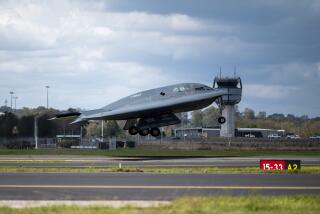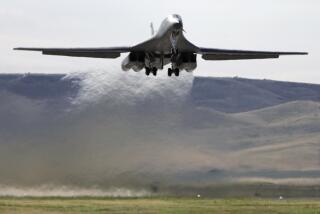Military Backers in House Urge Bush to Revive Stealth Program
- Share via
More than three years after Northrop Grumman Corp.’s last B-2 Stealth bomber rolled out of its Palmdale hanger, House defense leaders are urging President-elect George W. Bush to restart the production line to build as many as 40 more planes.
The latest push for the B-2 came as Northrop officials revealed they had made a presentation to Bush advisors detailing the costs of reviving the program, which was once a significant employer in Southern California and a major revenue source for the Century City-based defense contractor.
Though the B-2 would face an uphill battle because of competing defense priorities, it has strong advocates in the future Bush administration. Vice President-elect Dick Cheney and Secretary of Defense-nominee Donald H. Rumsfeld, both former secretaries of Defense, signed a letter in the late 1990s urging the Clinton administration to buy more B-2s.
In addition to a one-time cost of $3.8 billion to reconstitute the tools and equipment for the production line at the Plant 42 assembly site in Palmdale, Northrop said, each plane would cost about $500 million to build, or about $20 billion for 40 aircraft. The original program cost $44 billion, which included developing and producing 21 bombers.
“We discussed a scenario that would produce a total of 40 aircraft at an average rate of four a year for 10 years,” Northrop officials said in a statement. The first plane, which would have new electronics and improved stealth capabilities, would be ready for delivery within four years.
Although Bush has said no decision would be made until a “top-to-bottom” review of all military programs is completed, bringing back the B-2 production line would provide a significant economic boost to a battered aerospace industry in Southern California, economists said.
About 1,200 now work on the B-2 in Palmdale, mainly for maintenance and upgrades. But during the initial construction, Northrop had more than 4,000 workers building the plane and more than 150 subcontractors--many based in Southern California and employing thousands of more workers--providing parts and services.
“This would be terribly significant,” said David Myers, North County regional manager for the Los Angeles County Economic Development Corp., noting that the number of aerospace jobs locally has dropped by more than half, from about 125,000 in 1987 to 50,700 last year. “Putting some of those people back to work would be a tremendous benefit.”
Northrop officials said Friday that it completed the cost analysis of building additional planes at the request of Bush advisors, some of whom had previously advocated resuscitating the program.
The Air Force operates 21 B-2 bombers, far fewer than the 135 that were envisioned when initial production began in the early 1980s.
B-2 supporters in Congress said the additional planes are needed to overcome what they believe is a dangerous flaw in the U.S. military strategy for its long-range bomber fleet. About a third of the fleet consists of B-52s built in the 1960s, and the Air Force does not foresee developing a new bomber until 2040.
Loren Thompson, a defense analyst with the Arlington, Va.-based Lexington Institute, said the B-2’s long-range capabilities are becoming even more critical as pressure mounts to shutter foreign bases, leaving short-range strike aircraft useless.
“If we don’t build more B-2s we don’t have any obvious alternatives,” Thompson said. “The B-52 is 39 years old, it’s not stealthy, can’t penetrate hostile airspace, and there is a question how much longer it can fly.”
But Paul H. Nisbet, senior aerospace analyst at JSA Research Inc. in Newport, R.I., said the B-2 faces an uphill battle as a host of other military programs vie for funding.
“There are so many new ideas that are going to vie for money under the Bush administration that I think it is very unlikely that a very expensive endeavor is going to gain any steam at all.”
The plane, the most expensive military aircraft ever built, is a byproduct of the Cold War. With its radar-evading abilities, the plane was originally designed to penetrate Russian airspace and deliver nuclear bombs to targets deep within Russia. The plan was considered part of a strategic triad, augmenting land-based and submarine-based nuclear missiles.
But in recent years, its role has changed to fight more conventional battles, including dropping precision bombs during the Kosovo conflict in 1999. Supporters point to the plane’s success in the campaign during which the B-2 regularly made 30-hour round-trip bombing runs from Whiteman Air Base in Missouri to Yugoslavia. The B-2 flew 11% of the missions but accounted for 33% of the bombs that were dropped, according to a Pentagon report.
“It worked fantastically,” said Rep. Norman D. Dicks (D-Wash.), a longtime supporter of the bomber who urged Bush to consider the proposal at a round-table meeting with the president-elect Monday. “I basically told him I thought the B-2 was a revolutionary weapon and that the decision to halt it at 21 was the worst decision we ever made.”
More to Read
Inside the business of entertainment
The Wide Shot brings you news, analysis and insights on everything from streaming wars to production — and what it all means for the future.
You may occasionally receive promotional content from the Los Angeles Times.










